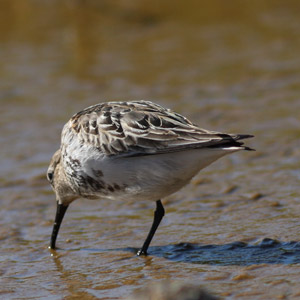Pratique | Débuter
Comment les oiseaux handicapés survivent-ils ?

Un Bécasseau variable (Calidris alpina) avec une seule patte.Photographie : Olivier Thoret
Introduction
Lors de vos promenades, vous avez peut-être déjà vu des oiseaux blessés ou avec des déformations graves, et vous vous êtes alors demandé : « mais comment font-ils pour survivre ? » Ces infirmités n’empêchent-elles pas l’oiseau de se nourrir ou d’échapper aux prédateurs ? Plusieurs auteurs ont rapporté des cas d’individus avec des difformités graves qui avaient apparemment réussi à s’en sortir, comme par exemple une buse borgne ou un barbican avec la plus grande partie de sa mandibule inférieure arrachée…
Olivier Thoret nous a transmis des clichés d’oiseaux handicapés, ce qui nous donne l’occasion de nous pencher sur l’étonnante robustesse des oiseaux. Nous remercions les autres photographes qui nous ont aidés à illustrer cet article.
Abstract
In the field, it is possible to notice birds with a range of injuries or disfiguring growths on feet, legs, wings or on the head. Several biologists or ringers have reported some birds with major injuries that had apparently coped, for example a Jackal Buzzard with one sightless eye or a severely disfigured Black-collared Barbet, possibly injured by a pellet gun and with most of its top mandible missing. But both birds were in a good condition. And most ringers will agree that a broken or deformed leg appears to have little impact on the apparent health of a bird, although it is not possible to confirm whether male birds with such injuries or deformities are successful in breeding attempts. Deformities or growths around the beak area also seem to have little effect on the bird’s mass or vigour. Birds therefore seem to be surprisingly robust.
As Oliver Thoret sent us several photos of handicaped birds, we’ll try to understand how birds can cope with disabilities.
Poursuivez la lecture de cet article, en vous abonnant dès maintenant !
Découvrez les Archives d’Ornithomedia.com
Pour seulement 10,00 €TTC/an (ou 6,00 € les 6 mois)
Profitez de plusieurs centaines d’articles en accès illimité et sans aucun engagement.
Compléments
À lire sur le web
- La galerie de Joan Gellatly: http://www.flickr.com/photos/joangee
- La galerie de Joe Rawles : http://www.flickr.com/photos/jdrphotography
Ouvrage recommandé
Le guide Ornitho Killian Mullarney et al
Sources
- Graham Grieve (2007). How does a disabled bird cope with its disability? Afring News online. 36:19-20.
- Julie A. Craves (1994). Passerines with Deformed Bills. North American Bird Bander. Volume 19 numéro 1.
- Marcelo Ferreira de Vasconcelos et Marcos Rodrigues (2006). Bill deformity in a White-winged Becard, Pachyramphus polychopterus, (Aves: Suboscines: Tityridae) from Minas Gerais, Brazil. Revista Brasileira de Ornitologia 14 (2). 165-166.
- Wikipedia. Variole aviaire. http://fr.wikipedia.org/wiki/Variole_aviaire
- RSPB (2009). Bird deformities. http://www.rspb.org.uk
- Christopher W. Thomson et Barbara A. Terkanian (1991). Abnormally long bill in a young Curve-billed Thrasher. Journal of Field Ornithology. Volime 62, numéro 2. pages 157-292. http://www.jstor.org/pss/4513618
- Iñigo Fajardo, Gabriel Babiloni, Yago Miranda (1999). Rehabilitated and wild barn owls (Tyto alba): dispersal, life expectancy and mortality in Spain. Biological Conservation Volume 94, numéro 3, juillet, Pages 287-295. http://www.sciencedirect.com/science/article/pii/S0006320700000033
- Bird Ecology Study Group, Nature Society (Singapore) (2005). Deformed bill. http://besgroup.blogspot.com/2006/06/deformed-bill.html
- Beata Matysiokova´ et Vladimi´r Remes? (2010). Responses to increased costs of activity during incubation in a songbird with female-only incubation: does feather colour signal coping ability? Octobre. Ornithologen-Gesellschaft. http://www.zoologie.upol.cz/clanky_pdf/JOrn_2011_MatRem.pdf
- Russel D. Dawson, Gary R. Brtolotti et Gillian L. Murza (2001). Sex-dependent frequency and consequences of natural handicaps in American Kestrels? Journal of Avian Biology. Numéro 32. Pages 351-357.
- Otto W. Tiemeier (1941). Repaired Bone Injuries in Birds. The Auk. Vol. 58, No. 3, pages 350-359. http://www.jstor.org/stable/4078953
- Juan A. Amat (1999). Foot Losses of Metal Banded Snowy Plovers (Pérdidas de Pies en Chorlitejos Patinegros (Charadrius Alexandrinus) con Anillas Metálicas). Journal of Field Ornithology. volume . 70, numéro 4. http://www.jstor.org/stable/4514448





 1 commentaire
1 commentaire
1 commentaire(s) sur ce sujet
Participer à la discussion !michel usdin
palavas les flots
Posté le 02 juillet 2015
très intéressant, comme toujours sur ornithomédia
j’aimerais qu’un ou plusieurs livres soient publiés…livres comprenant plein d’articles comme ça ; je préfère lire sur papier que sur écran !
mais on apprend vraiment beaucoup ! merci !!!